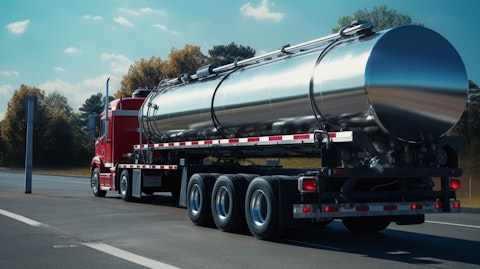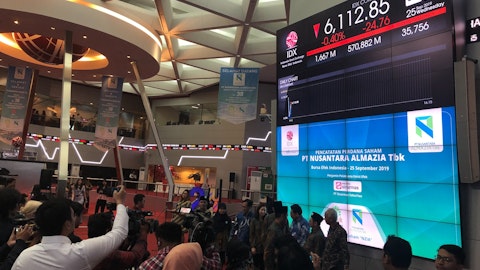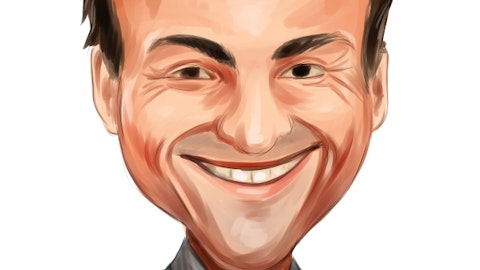Civitas Resources, Inc. (NYSE:CIVI) Q3 2023 Earnings Call Transcript November 8, 2023
Operator: Ladies and gentlemen, thank you for standing by. My name is Bhavish, and I will be your conference operator today. At this time, I would like to welcome everyone to the Civitas Resources’ Third Quarter 2023 Earnings Conference Call. [Operator Instructions] I will now hand the call over to John Wren, Director of Investor Relations. You may begin your conference.
John Wren: Thanks, operator, and good morning, everyone, and thanks for joining us. I’m joined today by our CEO, Chris Doyle; CFO, Marianella Foschi; and COO, Hodge Walker. I hope you’ve reviewed our earnings release, 10-Q and slide deck, all of which are available on our website. We will make forward-looking statements, which are subject to risks and uncertainties that could cause actual results to differ materially from our projections. Please read our full disclosures regarding forward-looking statements in our 10-Q and other SEC filings. We may also refer to certain non-GAAP financial metrics. Reconciliations to certain non-GAAP metrics can be found in yesterday’s release and our SEC filings. After Chris’s brief prepared remarks, we’ll all be available to take your questions. As always, please limit your time to one question and one follow-up as this allows us to get to more of your questions this morning. Now I’ll turn the call over to Chris.
Chris Doyle: Thanks, John, and good morning, everyone. The team once again delivered strong results this quarter and our new Permian and legacy DJ businesses are performing well against our expectations. Our results continue to prove that an E&P company with high-quality assets can return significant cash to shareholders while building scale through disciplined accretive transactions. Our recently announced Vencer acquisition, which should close as expected in January, further strengthens our ability to generate free cash and return it to shareholders. This deal is part of several recent steps to transform our company, adding high-quality scale and further diversifying our portfolio. Simply put, we’re more competitive and more durable enterprise today.
We recently celebrated our 2-year anniversary, which gave us an opportunity to reflect on what we’ve accomplished as a company and what we’ve delivered for our shareholders. In 2022, we paid $6.29 per share in dividends. In 2023, that number will grow to $7.60, add an additional $320 million of buybacks that have already been completed and we will return nearly $1 billion to shareholders in 2023 alone. That’s 15% of our current market cap in 1 year. Our strong shareholder return program will continue to grow in 2024. At strip, we expect the dividend will increase roughly 10% furthering our track record of delivering 1 of the most reliable and significant dividends in our industry. We’ve accomplished all of this while maintaining an unwavering commitment to our strong balance sheet.
Our plan to sell about $300 million in non-core assets is progressing well, and we’re on track to meet our mid-2024 target. Proceeds will help us reduce debt while also high-grading our portfolio. We continue to target 3 quarters of return of leverage longer term at mid-cycle prices and plan to be below 1 turn by the end of 2024, assuming $80 oil. We firmly believe that maintaining a strong capital structure is key to building a sustainable business that can deliver top shareholder returns. Let’s talk about integration. Since this summer, our focus has been on integrating the new Permian assets into Civitas and standing up a new team. We’ve built a proven Permian leadership team with decades of experience leading capital-efficient development programs across the basin.

In addition, I continue to be impressed by the talented members of the Tap Rock and Hibernia teams, many of whom are joining Civitas. Their dedication to maintaining safe, continuous and efficient operations has allowed us to accelerate operational handover in the Midland Basin to the end of this month. That’s over 2 months earlier than our original plan. Similarly in the Delaware, we’re on track to accelerate the operational handover by over a month. Bottom line, come January 1, Tap Rock and Hibernia operations will be fully integrated into Civitas. Our team is now finalizing plans for the Vencer integration and optimizing our 2024 development program. As always, we will be guided by a proven business model, which focuses on maximizing free cash flow and improving cash-on-cash returns.
Now let me quickly summarize our third quarter results. Total company production was in line with expectations in the third quarter averaging 235,000 BOE per day and 114,000 barrels of oil per day. In the DJ, volumes were 168,000 BOE per day in the upper half of our original guidance range. We continue to push the limits of operational efficiency here in the DJ, recently drilling 6, 4-mile laterals and an average spud to spud of 9 days. It’s a new company record. Importantly, the wells came in approximately 10% below predrill cost estimates. In the Permian, we produced 67,000 BOE per day for the quarter, which I note only reflects volumes after the transaction closed on August 2. Focusing in on August and September, Permian production averaged 101,000 BOE per day.
We closed the quarter strong, averaging approximately 111,000 BOE per day and 56,000 barrels of oil per day. Importantly, we remain on track to exit this year within our original Permian 5-month guidance range. Company-wide, we continue to target a year-end exit rate of about 280,000 BOE per day and have raised the midpoint of our full year production guidance. Capital investments in the third quarter were approximately $430 million, consistent with expectations. We ran 2 rigs in the DJ, 7 in the Permian during the quarter. And as planned, we’ve dropped 2 rigs in the Permian in October and will drop to 4 rigs by year-end before closing Vencer. In the DJ, we’ll maintain our 2-rig program and have reduced completion activity in the fourth quarter as planned.
As we look toward the remainder of the year, we successfully increased our working interest in a few high-return pads and elected to participate in additional non-op activity in the core of the DJ Basin. As a result of these investments, combined with improved drilling cycle times, we’re electing to increase our capital investments by about $60 million, midpoint to midpoint, bringing the new midpoint to $1.34 billion. These are high-return investments that set us up well heading into 2024. In closing, let me reiterate today’s key takeaways. First, our legacy DJ and new Permian businesses are both performing well. Our integration is ahead of schedule, and we have the flexibility to invest capital across a portfolio of very high-return assets in multiple basins.
Second, our recent acquisitions have created a stronger, more balanced Civitas with significant duration and a peer-leading shareholder return program. As I’ve said before, scale matters, but so does depth and quality of inventory and efficient execution. Scale, asset quality and operational excellence are the key ingredients to sustaining and growing shareholder returns. Lastly, we know the importance of a premier balance sheet. We’re advancing our noncore asset sales as planned, have a very strong outlook for free cash flow at current prices. We expect to return to our optimal leverage ratio of less than 1 turn by the end of 2024, assuming $80 oil. Thank you for your interest in Civitas. And operator, we’re now happy to take questions.
See also 11 Best Dividend Stocks on Robinhood and 12 Best Undervalued Dividend Stocks To Buy Now.
Q&A Session
Follow Civitas Resources Inc. (NYSE:CIVI)
Follow Civitas Resources Inc. (NYSE:CIVI)
Operator: [Operator Instructions] Our first question comes from the line of Neal Dingmann from Truist Securities.
Neal Dingmann: Nice job on the solid results. My first question is on the Permian. Could you remind me your assumed 2024 step-up on the Permian D&C as part of that reiterated guide, you mentioned in the release. And I’m just wondering, does this include any step-up in project size.
Chris Doyle: Yes. Thanks, Neal. So you look at our midpoint in 2024, $2.1 billion. That split between the Permian and the DJ is roughly 55-45 when you include Vencer, so we’ll be allocating slightly more than half of our capital to the Permian in 2024. Your second question is a really interesting one, and it’s what the team is currently working on and just overall project size. As we looked at these transactions, all 3 of them, we had an underwriting case, and then we have a case that indicates there’s additional resource that could be allocated capital. And so 1 of the projects the team is working on is looking at overall project size and how do we most efficiently allocate capital to zones that have very strong returns, but may not have been part of the underwriting case whether they’re shallower zones or zones such as the Wolfcamp B. So I would say that’s still in progress, but we’re very excited with how 2024 is setting up and excited to continue to execute.
Neal Dingmann: It looks like a great runway ahead. And then my second question, just on the DJ appears, the Watkins area just continues to notably outperform. I think that’s even an understatement. I’m just wondering, based on the results you’ve seen now for a few quarters, have you changed future expectations here? And I was just wondering, is it the extended reach wells or what continues to drive this outperformance?
Chris Doyle: Yes. I think our outperform is an understatement. It’s conservative as I’m, even I see that. The Watkins area is — has emerged as a core part of our portfolio and a core part of the DJ Basin. I’d say the outperformance is really attributed to a couple of things. One is, as we stepped in and stepped into full development in this area, we were conservative in our expectations, rightfully so. The team has done a fantastic job of executing, continuing to deliver and outperform our investment case and our type curves in that area. And that’s for, call it, a 2-mile well. When you add the extended reach wells and we brought on a bunch of 3 milers, I note the 4 milers, it’ll be interested to see how they perform. But the 3 milers in this area, we were likewise very conservative on the degradation that we could see in that third mile.
Last quarter, we noted the outperformance. Some of those pads have started to turn over. They continue to outperform our expectations, and they are performing currently in line with 2-mile expectations. I’m not going to say that there is no degradation in the third mile. I don’t think that’s the case. I would say that early results have been really, really positive. And so as we looked at — and this really leads into deciding to deploy $60 million of additional capital. Some of that is directed at these high-quality, high-return pads in the Watkins area. And so we’re excited about what we’re seeing there, excited about the team continuing to execute. And I would say that while we’ve reflected that outperformance, we are still being somewhat cautious in how we think about 2024, but the team will continue to dial that in as we see more and more performance, and we’re excited to share that with you guys.
Operator: Our next question comes from the line of Leo Mariani from Roth MKM.
Leo Mariani: I wanted to follow up a little bit on kind of your thoughts around M&A. I know you’re kind of working on selling some assets, but obviously, you’ve been an aggressive consolidator in the Permian after being aggressive consolidator of the DJ in past years. So as you’re sort of thinking about the strategy going forward, are you still kind of looking to go out there and kind of consolidate DJ or I’m sorry, Permian assets at this point in time?
Chris Doyle: Yes. Thanks, Leo. We have been fairly busy, I would say, looking for ways to scale, diversify and extend our business model. The hurdle for us to go after an acquisition is very high. We always go back to the 4 pillars of our strategy, which is these assets have to be able to generate free cash flow. That is a credit to asset quality. We have to be able to maintain a premier balance sheet. We’re in the midst of, as you mentioned, the noncore asset sales to help preserve our balance sheet strength. And these assets have to extend the duration of, I think, the leading shareholder return framework in our industry. When we look back at the 3 acquisitions that we’ve made in the Permian, each of those progressed all of those pillars.
And so I’d say the hurdle for us to be interested is pretty high. We’re not just looking at getting bigger. It’s how do we improve shareholder returns and how do we extend the duration of shareholder returns. I would say, even with Vencer, we mentioned this on the previous call, we weren’t necessarily aggressively looking to do the next transaction. But when we saw a transaction of that quality, that scale, that fits with our existing position in the Midland Basin and Permian more broadly, we did take the opportunity to pull that in. Will those opportunities continue to show themselves? We’ll see. But I think we’ve shown — the management team has shown that we will be very disciplined and also opportunistic in how we think about extending this business model.
Leo Mariani: Okay. I appreciate the response there. So I know you guys have spoken about potentially raising more capital for Vencer over time. Just wanted to get your kind of updated thoughts around that? And then also just curious how the Vencer deal affects your cash tax position in 2024?
Chris Doyle: Yes. I’ll kick this off and then kick it over to Marianella. So the way we structured the Vencer transaction was very deliberate to provide extreme flexibility in how we finance the transaction. Because it was coming so soon off the heels of Hibernia and Tap Rock, we wanted the flexibility of that deferred payment. And so we negotiated that deferred payment. Our plan is, as we look at our potential ways to finance the transaction is, we like having that flexibility, certainly, with where equity is and the volatility in the market, we’re not in a huge hurry to accelerate that payment for what is 10% discount on that payment. But I’ll — let me kick it to Marianella to flesh that out and then talk about cash tax as well.
Marianella Foschi: Sure. Leo, thanks for your question. So we have entered flexibility in our capital structure right now. Like Chris said, we structured the payments such that roughly a 10% cost of capital. We see tremendous value in our equity today. We set that when we did the equity offering and the stock was down about 10%. So we are sitting on a fully financed plan for Vencer and the deferred option even more so now is more attractive. In terms of the cash taxes, so look, when you think about us as a company potentially hitting AMT into 2025, our cash taxes are going to be pretty minimal until that point. A lot of it is what oil prices you assume. It’s $70 oil, we’re never expected to be in an AMT position. At $80 oil, we are, the soonest we could possibly be, which is 2025.




